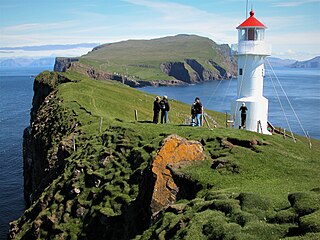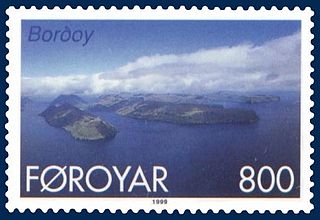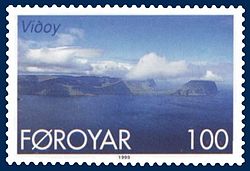
Ánir, also Ánirnar is a village in the Faroe Islands on the northern island of Borðoy. In 2007 it had a population of 16, but with the expansion of the area with the new apartments above the old settlement the population has increased to 55 in 2013.

Hestur is an island in the central Faroe Islands, to the west of Streymoy and the south of Koltur. Hestur means horse in Faroese.

Hvannasund is a village and municipality in the Faroe Islands, an autonomous territory within the Kingdom of Denmark.

Kirkja is a village on the island of Fugloy, Faroe Islands. It is located on the south-tip of the island, and its land is stretching all over the western side of the island, including a small enclave in the now uninhabited Skarðsvík. Here archaeologists have located an old settlement that has probably been only a part-time settlement used either by people from Kirkja or Hattarvík.

Nólsoy is an island and village with a population of 230 people in central Faroe Islands, 4km east of the capital Tórshavn in Streymoy.

Suðuroy is the southernmost of the Faroe Islands. The island covers 163.7 square kilometres (63.2 sq mi). In 2018 the population was 4,601. Suðuroy region (sýsla) comprises this island and Lítla Dímun, the next isle northward in the Faroes, which is uninhabited.

Mykines is the westernmost of the 18 main islands of the Faroese Archipelago.

Kalsoy is an island in the north-east of the Faroe Islands of Denmark between Eysturoy and Kunoy. The name means man island; by contrast with the parallel island to the east, Kunoy, the name of which means woman island.

Kunoy is an island located in the north-east of the Faroe Islands between Kalsoy to the west and Borðoy to the east.

Svínoy is an island in the north-east of the Faroe Islands, to the east of Borðoy and Viðoy. It takes its name from Old Norse, Svíney, meaning "Swine Isle". Svinoy also refers to a section of the ocean where North Atlantic water flows into the Norwegian Sea. There is a similarly named island, Swona, in the Orkney Islands.

Fugloy is the easternmost island in the Faroe Islands.

Borðoy is an island in the north-east of the Faroe Islands. Its name means 'headland island'. There are eight settlements: Klaksvík, Norðoyri, Ánir, Árnafjørður, Strond, Norðtoftir, Depil and Norðdepil.

Koltur is an island in the Faroe Islands, located to the west of Streymoy and to the north-west of Hestur. The name 'Koltur' means 'colt', in contrast with the name of the larger island to the south-east, 'Hestur', which means 'horse'. The island has just one settlement, Koltur. It was abandoned in the 1980s by the sheep-farmers whose flocks grazed on the southern part of the island. Since then only two people have returned. Koltur has two mountains, Kolturshamar and Fjallið (101m) which strictly speaking is not a mountain, the name however translates directly as "The Mountain" and is considered by many as the smallest mountain in the country.

Skúgvoy is an island in the central Faroe Islands, located to the south of Sandoy.

Streymoy is the largest and most populated island of the Faroe Islands. The capital, Tórshavn, is located on its southeast coast. The name means "island of currents". It also refers to the largest region of the country that also includes the islands of Hestur, Koltur and Nólsoy.

Vágar is one of the 18 islands in the archipelago of the Faroe Islands and the most westerly of the large islands. With a size of 178 square kilometres, it ranks third in size, behind Streymoy and Eysturoy. Vágar region also comprises the island of Mykines.

Eysturoy is a region and the second-largest of the Faroe Islands, both in size and population.

Viðareiði is the northernmost settlement in the Faroe Islands and lies on the Island of Viðoy, which belongs to the Norðoyar Region.

Norðdepil is a town on the east coast of the island of Borðoy in the Norðoyar Region of the Faroe Islands.

The fauna of the Faroe Islands is characterized by the remote location of the islands in the North Atlantic Ocean. There are few terrestrial species, but an abundance of breeding seabirds and marine animals. Some subspecies and breeds are endemic. All land mammals were introduced by humans.





















